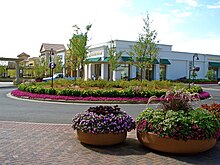
A shopping mall is a North American term for a large indoor shopping center, usually anchored by department stores. The term "mall" originally meant a pedestrian promenade with shops along it, but in the late 1960s, it began to be used as a generic term for the large enclosed shopping centers that were becoming commonplace at the time. In the U.K., such complexes are considered shopping centres, though "shopping center" covers many more sizes and types of centers than the North American "mall". Other countries may follow U.S. usage while still others follow U.K. usage. In Canadian English, and often in Australia and New Zealand, the term 'mall' may be used informally but 'shopping centre' or merely 'centre' will feature in the name of the complex. The term 'mall' is less-commonly a part of the name of the complex.
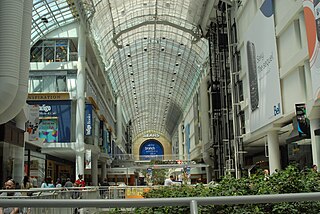
A shopping center, shopping centre or shopping mall, also called a shopping complex, shopping arcade, shopping plaza or galleria, is a group of shops built together, sometimes under one roof.

Pedestrian zones are areas of a city or town reserved for pedestrian-only use and in which most or all automobile traffic is prohibited. Converting a street or an area to pedestrian-only use is called pedestrianisation.

A strip mall, strip center or strip plaza is a type of shopping center common in North America where the stores are arranged in a row, with a sidewalk in front. Strip malls are typically developed as a unit and have large parking lots in front. Many of them face major traffic arterials and tend to be self-contained with few pedestrian connections to surrounding neighborhoods. Smaller strip malls may be called mini-malls, while larger ones may be called power centers or big box centers. In 2013, The New York Times reported that the United States had 65,840 strip malls. In 2020, The Wall Street Journal wrote that in the United States, despite the continuing retail apocalypse starting around 2010, investments and visitor numbers were increasing to strip malls.

Lenox Square is a shopping mall in the Buckhead district of Atlanta, Georgia. With 198 tenants and 1,558,678 square feet (144,805.9 m2) of gross leasable area, it is the third-largest mall in Georgia. The mall is currently owned and managed by Simon Property Group, and is considered a sister mall to the adjacent, Simon-owned Phipps Plaza. As of 2021, the mall is anchored by department stores Bloomingdale's, Macy's, and Neiman Marcus.

A retail park is a type of shopping centre found on the fringes of most large towns and cities in the United Kingdom and other European countries. They form a key aspect of European retail geographies, alongside indoor shopping centres, standalone stores like hypermarkets and more traditional high streets.

A dead mall is a shopping mall with a high vacancy rate or a low consumer traffic level, or that is deteriorating in some manner.

An outlet store, factory outlet or factory store is a brick and mortar or online store where manufacturers sell their merchandise directly to the public. Products at outlet stores are usually sold at reduced prices compared to regular stores due to being overstock, closeout, factory seconds, or lower-quality versions manufactured specifically for outlets. Traditionally, a factory outlet was a store attached to a factory or warehouse, sometimes allowing customers to watch the production process, such as in the original L.L. Bean store. In modern usage, outlet stores are typically manufacturer-branded stores such as Gap or Bon Worth grouped together in outlet malls. The invention of the factory outlet store is often credited to Harold Alfond, founder of the Dexter Shoe Company.

In retail, an "anchor tenant", sometimes called an "anchor store", "draw tenant", or "key tenant", is a considerably larger tenant in a shopping mall, often a department store or retail chain. They are typically located at the ends of malls, sometimes in the middle. With their broad appeal, they are intended to attract a significant cross-section of the shopping public to the center. They are often offered steep discounts on rent in exchange for signing long-term leases in order to provide steady cash flows for the mall owners. Some examples of anchor stores in the United States are: Macy's, Sears, JCPenney, Nordstrom, Neiman Marcus, Saks Fifth Avenue, Dillard's, Kohl's, and Target. And in Canada; Hudson's Bay, Sears (formerly), Target (formerly), Zellers, Nordstrom/Nordstrom Rack (formerly), TJX Companies, Saks Fifth Avenue, Sporting Life.
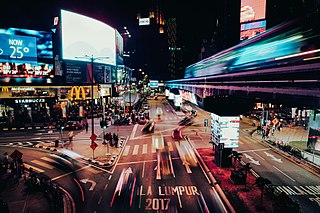
Bukit Bintang is the shopping and entertainment district of Kuala Lumpur, Malaysia. It encompasses Jalan Bukit Bintang and its immediate surrounding areas. The area has long been Kuala Lumpur's most prominent retail belt that is home to many landmark shopping centres, al-fresco cafés, bars, night markets, food street, mamak stalls as well as hawker-type eateries. This area is popular among tourists and locals, especially among the youths.

Arbor Lakes is a commercial and residential district located in downtown Maple Grove, Minnesota, United States. Construction of Arbor Lakes began in the late 1990s with a simulacrum of a traditional American Main Street designed in neotraditional style. The second phase included the Shoppes at Arbor Lakes, Minnesota's first lifestyle center, which includes neotraditional elements. The third phase, The Fountains at Arbor Lakes, is approximately 850,000 square feet (79,000 m2) in size and includes a Main Street-inspired entrance, with two hotels, several restaurants, and a number of junior anchors. The fourth phase, The Village at Arbor Lakes, which will be 295,470 square feet (27,450 m2) when completed, will include a Home2 Suites by Hilton hotel, a SpringHill Suites hotel, up to 700 apartments, and some retail.

Paramus Park is a shopping mall located in Paramus, New Jersey, United States. It opened in 1974, is owned by Brookfield Properties, and has a gross leasable area (GLA) of 770,941 sq ft (71,622.8 m2).
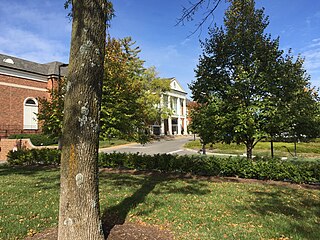
Plaza Frontenac is an upscale, two-level, enclosed, regional shopping center in Frontenac, Missouri. Opened in 1974 and anchored by Saks Fifth Avenue and Neiman Marcus, it has high-end tenants, many of which are unique to the region. Since 2018, Plaza Frontenac has been owned by a joint venture between Canada Pension Plan Investment Board and Brookfield Properties.

River Park Square is a shopping mall and entertainment complex in Spokane, Washington. The shopping center was originally opened in 1974. Following years of decline, the center was redeveloped in 1999 using public and private funds in an effort to revitalize downtown Spokane. The mall, still privately owned by Cowles Company, is anchored by Nordstrom and contains an outpost of AMC Theatres.

Bridgeport Village is a lifestyle center located in Tualatin and Tigard, Oregon, United States, operated by CenterCal Properties. The center opened on May 19, 2005 and is located in one of the Portland metropolitan area's most affluent areas. The center has a variety of services, including valet service, restaurant reservations, a courtesy shuttle to vehicles, and umbrellas available to borrow for free. The center features a water and fire fountain, and an Italian gazebo and kiosks by Neri.

Pelican Place at Craft Farms is a 372,000-square-foot (34,600 m2) lifestyle center in Gulf Shores, Alabama. It is planned to expand to 650,000 square feet (60,000 m2). It was designed by CMH Architects of Birmingham, the firm that also designed the Eastern Shore Centre in nearby Spanish Fort. It was developed by Colonial Properties as part of their "Pinnacle" brand of lifestyle centers and was originally known as the Pinnacle at Craft Farms. In September 2015, Langley Properties, the development's most recent management company, sold Pelican Place to RCG Ventures of Atlanta, Georgia, for more than $18 million.
Tanger Outlets Southaven is an outlet mall in Southaven, Mississippi, just outside Memphis, Tennessee. The mall, located at the intersection of I-55/I-69 and Church Road, began construction in January 2015 and opened in November 2015. Tanger Outlets Southaven is the first outlet mall in the Memphis metro area.

A power center or big-box center is a shopping center with typically 250,000 to 600,000 square feet of gross leasable area that usually contains three or more big box anchor tenants and various smaller retailers, where the anchors occupy 75–90% of the total area.
The retail format influences the consumer's store choice and addresses the consumer's expectations. At its most basic level, a retail format is a simple marketplace, that is; a location where goods and services are exchanged. In some parts of the world, the retail sector is still dominated by small family-run stores, but large retail chains are increasingly dominating the sector, because they can exert considerable buying power and pass on the savings in the form of lower prices. Many of these large retail chains also produce their own private labels which compete alongside manufacturer brands. Considerable consolidation of retail stores has changed the retail landscape, transferring power away from wholesalers and into the hands of the large retail chains.
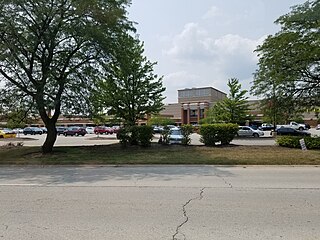
Edens Plaza is a strip mall in the town of Wilmette, Illinois. It was built by Carson Pirie Scott & Co. (Carson's) in 1956, and, until 2018, was anchored by one of their stores. It is located on a triangular parcel of land between Lake Avenue, Skokie Boulevard and the Edens Expressway.
